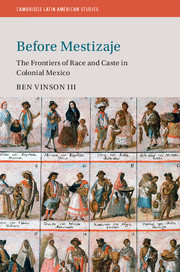Book contents
- Before Mestizaje
- Cambridge Latin American Studies
- Before Mestizaje
- Copyright page
- Dedication
- Contents
- Figures
- Additional material
- Preface
- 1 Wayward Mixture: The Problem of Race in the Colonies
- 2 Mestizaje 1.0: The Moment Mixture Had Modern Meaning
- 3 “Castagenesis” and the Moment of Castizaje
- 4 The Jungle of Casta Extremes
- 5 Extreme Mixture in a Theater of Numbers
- 6 Betrothed: Marrying into the Extremes
- 7 Betrothed: Identity’s Riddle
- 8 Betrayed
- 9 Colonial Bequests
- Historian’s Coda: Casta States of Mind
- Book part
- References
- Index
- Titles published in the series (continued from page iii)
- References
References
Published online by Cambridge University Press: 28 November 2017
- Before Mestizaje
- Cambridge Latin American Studies
- Before Mestizaje
- Copyright page
- Dedication
- Contents
- Figures
- Additional material
- Preface
- 1 Wayward Mixture: The Problem of Race in the Colonies
- 2 Mestizaje 1.0: The Moment Mixture Had Modern Meaning
- 3 “Castagenesis” and the Moment of Castizaje
- 4 The Jungle of Casta Extremes
- 5 Extreme Mixture in a Theater of Numbers
- 6 Betrothed: Marrying into the Extremes
- 7 Betrothed: Identity’s Riddle
- 8 Betrayed
- 9 Colonial Bequests
- Historian’s Coda: Casta States of Mind
- Book part
- References
- Index
- Titles published in the series (continued from page iii)
- References
- Type
- Chapter
- Information
- Before MestizajeThe Frontiers of Race and Caste in Colonial Mexico, pp. 255 - 276Publisher: Cambridge University PressPrint publication year: 2017



